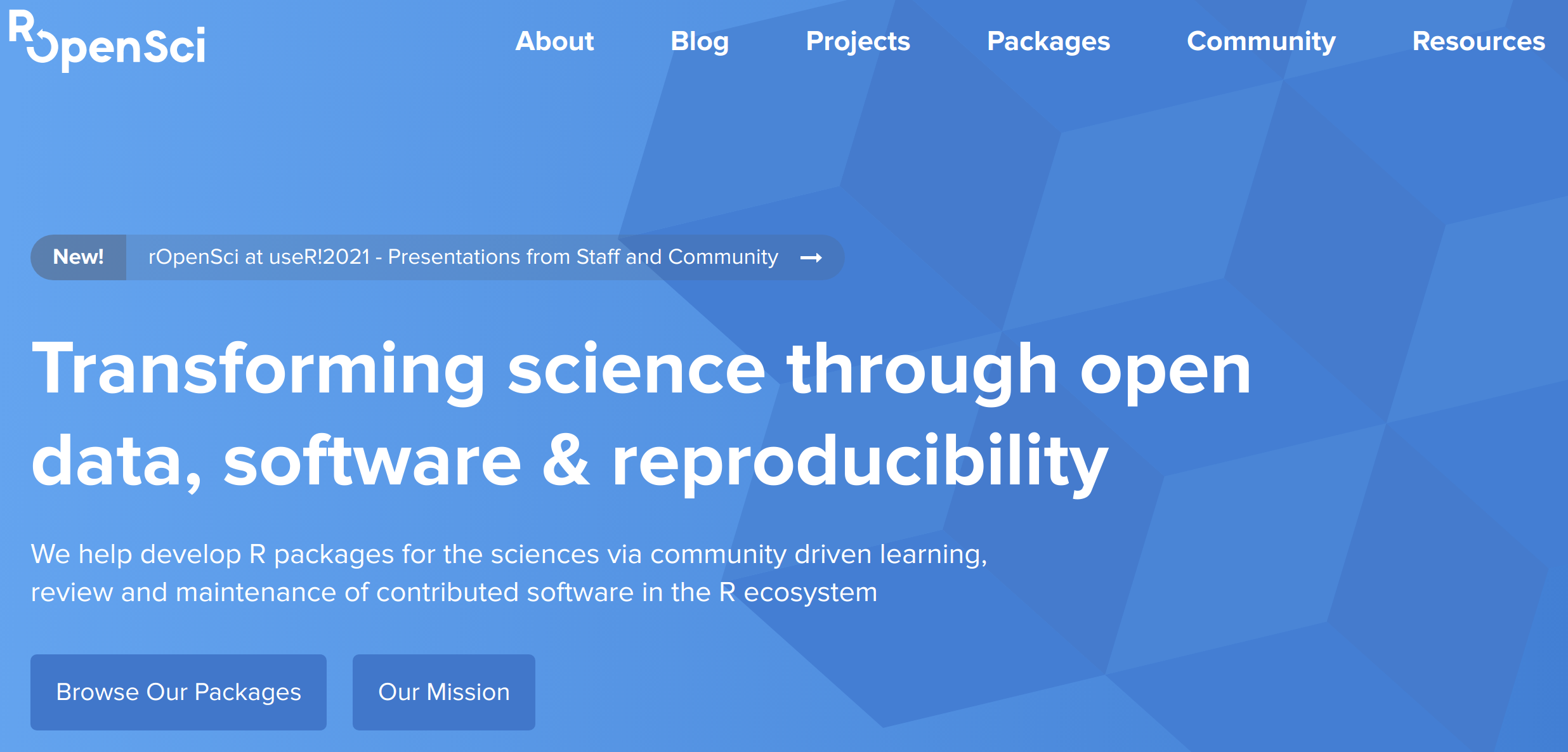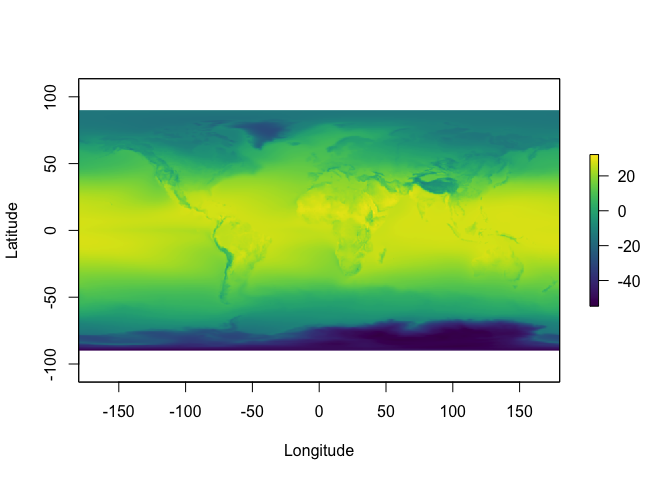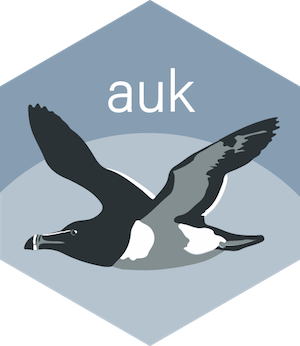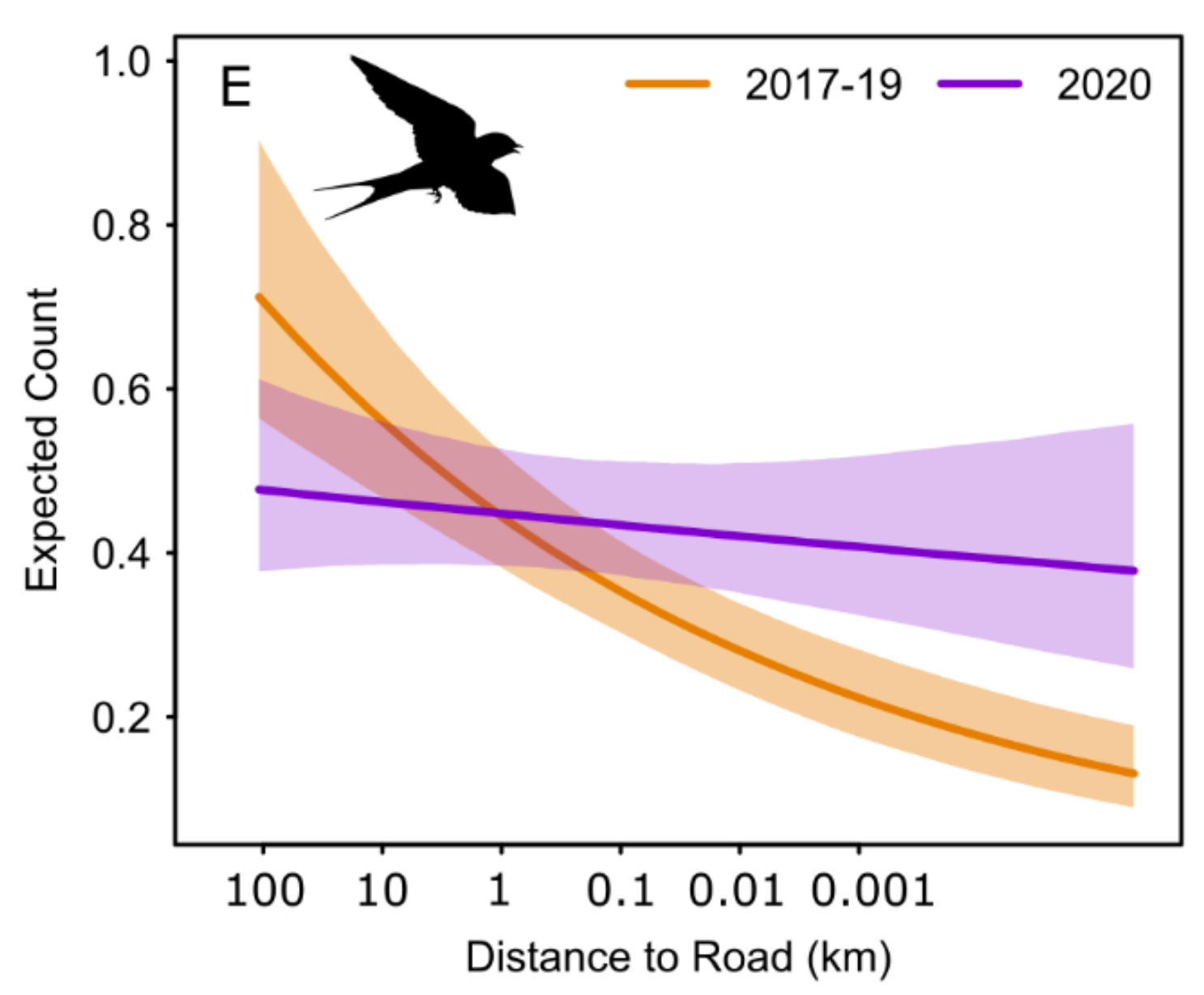class: title-slide, nologo, nobar, split-50 ![:spacer 10px]() .hanging[ ### Stefanie E. LaZerte]  ![:spacer 30px]() .medium[ **ESA 2021** INS 6: **Open Data Resources During a Global Pandemic** **Live Discussion**: Tuesday August 3 2021, 11am - 12pm Pacific ] ![:spacer 30px]() # Using rOpenSci packages to access open data for ecology .footnote[ <svg viewBox="0 0 512 512" style="height:1em;position:relative;display:inline-block;top:.1em;" xmlns="http://www.w3.org/2000/svg"> <title>Twitter</title> <path d="M496,109.5a201.8,201.8,0,0,1-56.55,15.3,97.51,97.51,0,0,0,43.33-53.6,197.74,197.74,0,0,1-62.56,23.5A99.14,99.14,0,0,0,348.31,64c-54.42,0-98.46,43.4-98.46,96.9a93.21,93.21,0,0,0,2.54,22.1,280.7,280.7,0,0,1-203-101.3A95.69,95.69,0,0,0,36,130.4C36,164,53.53,193.7,80,211.1A97.5,97.5,0,0,1,35.22,199v1.2c0,47,34,86.1,79,95a100.76,100.76,0,0,1-25.94,3.4,94.38,94.38,0,0,1-18.51-1.8c12.51,38.5,48.92,66.5,92.05,67.3A199.59,199.59,0,0,1,39.5,405.6,203,203,0,0,1,16,404.2,278.68,278.68,0,0,0,166.74,448c181.36,0,280.44-147.7,280.44-275.8,0-4.2-.11-8.4-.31-12.5A198.48,198.48,0,0,0,496,109.5Z"></path></svg> @steffilazerte <svg viewBox="0 0 512 512" style="height:1em;position:relative;display:inline-block;top:.1em;" xmlns="http://www.w3.org/2000/svg"> <title>GitHub</title> <path d="M256,32C132.3,32,32,134.9,32,261.7c0,101.5,64.2,187.5,153.2,217.9a17.56,17.56,0,0,0,3.8.4c8.3,0,11.5-6.1,11.5-11.4,0-5.5-.2-19.9-.3-39.1a102.4,102.4,0,0,1-22.6,2.7c-43.1,0-52.9-33.5-52.9-33.5-10.2-26.5-24.9-33.6-24.9-33.6-19.5-13.7-.1-14.1,1.4-14.1h.1c22.5,2,34.3,23.8,34.3,23.8,11.2,19.6,26.2,25.1,39.6,25.1a63,63,0,0,0,25.6-6c2-14.8,7.8-24.9,14.2-30.7-49.7-5.8-102-25.5-102-113.5,0-25.1,8.7-45.6,23-61.6-2.3-5.8-10-29.2,2.2-60.8a18.64,18.64,0,0,1,5-.5c8.1,0,26.4,3.1,56.6,24.1a208.21,208.21,0,0,1,112.2,0c30.2-21,48.5-24.1,56.6-24.1a18.64,18.64,0,0,1,5,.5c12.2,31.6,4.5,55,2.2,60.8,14.3,16.1,23,36.6,23,61.6,0,88.2-52.4,107.6-102.3,113.3,8,7.1,15.2,21.1,15.2,42.5,0,30.7-.3,55.5-.3,63,0,5.4,3.1,11.5,11.4,11.5a19.35,19.35,0,0,0,4-.4C415.9,449.2,480,363.1,480,261.7,480,134.9,379.7,32,256,32Z"></path></svg> steffilazerte <svg viewBox="0 0 512 512" style="height:1em;position:relative;display:inline-block;top:.1em;" xmlns="http://www.w3.org/2000/svg"> <title>World wide web</title> <path d="M256,48C141.13,48,48,141.13,48,256s93.13,208,208,208,208-93.13,208-208S370.87,48,256,48Z" style="fill:none;stroke:#000;stroke-miterlimit:10;stroke-width:32px"></path> <path d="M256,48c-58.07,0-112.67,93.13-112.67,208S197.93,464,256,464s112.67-93.13,112.67-208S314.07,48,256,48Z" style="fill:none;stroke:#000;stroke-miterlimit:10;stroke-width:32px"></path> <path d="M117.33,117.33c38.24,27.15,86.38,43.34,138.67,43.34s100.43-16.19,138.67-43.34" style="fill:none;stroke:#000;stroke-linecap:round;stroke-linejoin:round;stroke-width:32px"></path> <path d="M394.67,394.67c-38.24-27.15-86.38-43.34-138.67-43.34s-100.43,16.19-138.67,43.34" style="fill:none;stroke:#000;stroke-linecap:round;stroke-linejoin:round;stroke-width:32px"></path> <line x1="256" y1="48" x2="256" y2="464" style="fill:none;stroke:#000;stroke-miterlimit:10;stroke-width:32px"></line> <line x1="464" y1="256" x2="48" y2="256" style="fill:none;stroke:#000;stroke-miterlimit:10;stroke-width:32px"></line></svg> steffilazerte.ca ] .footnote-right[ <svg viewBox="0 0 512 512" style="height:1em;position:relative;display:inline-block;top:.1em;" xmlns="http://www.w3.org/2000/svg"> <title>Twitter</title> <path d="M496,109.5a201.8,201.8,0,0,1-56.55,15.3,97.51,97.51,0,0,0,43.33-53.6,197.74,197.74,0,0,1-62.56,23.5A99.14,99.14,0,0,0,348.31,64c-54.42,0-98.46,43.4-98.46,96.9a93.21,93.21,0,0,0,2.54,22.1,280.7,280.7,0,0,1-203-101.3A95.69,95.69,0,0,0,36,130.4C36,164,53.53,193.7,80,211.1A97.5,97.5,0,0,1,35.22,199v1.2c0,47,34,86.1,79,95a100.76,100.76,0,0,1-25.94,3.4,94.38,94.38,0,0,1-18.51-1.8c12.51,38.5,48.92,66.5,92.05,67.3A199.59,199.59,0,0,1,39.5,405.6,203,203,0,0,1,16,404.2,278.68,278.68,0,0,0,166.74,448c181.36,0,280.44-147.7,280.44-275.8,0-4.2-.11-8.4-.31-12.5A198.48,198.48,0,0,0,496,109.5Z"></path></svg> @rOpenSci <svg viewBox="0 0 512 512" style="height:1em;position:relative;display:inline-block;top:.1em;" xmlns="http://www.w3.org/2000/svg"> <title>World wide web</title> <path d="M256,48C141.13,48,48,141.13,48,256s93.13,208,208,208,208-93.13,208-208S370.87,48,256,48Z" style="fill:none;stroke:#000;stroke-miterlimit:10;stroke-width:32px"></path> <path d="M256,48c-58.07,0-112.67,93.13-112.67,208S197.93,464,256,464s112.67-93.13,112.67-208S314.07,48,256,48Z" style="fill:none;stroke:#000;stroke-miterlimit:10;stroke-width:32px"></path> <path d="M117.33,117.33c38.24,27.15,86.38,43.34,138.67,43.34s100.43-16.19,138.67-43.34" style="fill:none;stroke:#000;stroke-linecap:round;stroke-linejoin:round;stroke-width:32px"></path> <path d="M394.67,394.67c-38.24-27.15-86.38-43.34-138.67-43.34s-100.43,16.19-138.67,43.34" style="fill:none;stroke:#000;stroke-linecap:round;stroke-linejoin:round;stroke-width:32px"></path> <line x1="256" y1="48" x2="256" y2="464" style="fill:none;stroke:#000;stroke-miterlimit:10;stroke-width:32px"></line> <line x1="464" y1="256" x2="48" y2="256" style="fill:none;stroke:#000;stroke-miterlimit:10;stroke-width:32px"></line></svg> rOpenSci.org ] --- class: nobar, nologo  ??? rOpenSci is an orgnaization, which, among other things curates a collection of peer-reviewed packages to support open data, open science and reproducibility --- # Open data  ![:spacer 100px]() .center[ **We do this by** "Creating technical infrastructure in the form of carefully vetted, staff and community-contributed R software tools that **lower barriers to working with scientific data sources on the web**"] ![:spacer 30px]() .center[ ### Open Data <svg viewBox="0 0 512 512" style="height:1em;position:relative;display:inline-block;top:.1em;" xmlns="http://www.w3.org/2000/svg"> <title>Right Arrow</title> <polyline points="268 112 412 256 268 400" style="fill:none;stroke:#000;stroke-linecap:round;stroke-linejoin:round;stroke-width:48px"></polyline> <line x1="392" y1="256" x2="100" y2="256" style="fill:none;stroke:#000;stroke-linecap:round;stroke-linejoin:round;stroke-width:48px"></line></svg> Open Science <svg viewBox="0 0 512 512" style="height:1em;position:relative;display:inline-block;top:.1em;" xmlns="http://www.w3.org/2000/svg"> <title>Right Arrow</title> <polyline points="268 112 412 256 268 400" style="fill:none;stroke:#000;stroke-linecap:round;stroke-linejoin:round;stroke-width:48px"></polyline> <line x1="392" y1="256" x2="100" y2="256" style="fill:none;stroke:#000;stroke-linecap:round;stroke-linejoin:round;stroke-width:48px"></line></svg> Better Science ] ??? - Large, global datasets can be unweildly, so - Lowering barriers is important because we can have all the open data in the world, but if scientists can't access them, it's moot - I'm going to highlight some rOpenSci packages which can be used to access large, global datasets for ecological research in different situations --- # Open data to study ecology ### Complement field data ![:spacer 15px]() <!-- For HTML Version: --> <center> <blockquote class="twitter-tweet"><p lang="en" dir="ltr">We also use satellite and weather data from <a href="https://twitter.com/NASA?ref_src=twsrc%5Etfw">@NASA</a> & <a href="https://twitter.com/NOAA?ref_src=twsrc%5Etfw">@NOAA</a> for modeling and forecasting rodent abundances collected by <a href="https://twitter.com/skmorgane?ref_src=twsrc%5Etfw">@skmorgane</a>'s group (currently the fantastic team of <a href="https://twitter.com/bleds22e?ref_src=twsrc%5Etfw">@bleds22e</a> & <a href="https://twitter.com/diaz_renm?ref_src=twsrc%5Etfw">@diaz_renm</a> soon to be joint by <a href="https://twitter.com/patdumandan?ref_src=twsrc%5Etfw">@patdumandan</a>).</p>— Ethan White (@ethanwhite) <a href="https://twitter.com/ethanwhite/status/1263442365362077696?ref_src=twsrc%5Etfw">May 21, 2020</a></blockquote> <script async src="https://platform.twitter.com/widgets.js" charset="utf-8"></script> </center> <!-- For PDF Version: --> <!--  --> ??? - This tweet was inspired by a rOpenSci blog post asking how scientists use open data in their work. - What you can see here is an example of using open data to complement ecological field work. - This works particularly well in ecology with data related to weather, soil and other large-scale landscape metrics. - Specially in this example, Ethan's lab is using data from NASA and NOAA --- class: split-60, space-list # Open data to study ecology ### Complement field data ![:spacer 15px]() .footnote[.small[***rOpenSci blog** [POWER to the People](https://ropensci.org/blog/2019/05/14/nasapower/) by Adam Sparks]] .columnl[ - **rnoaa: [NOAA](https://www.ncdc.noaa.gov/) weather, climate, tides, ice, etc.** .small[(Scott Chamberlain, 2021)] - **nasapower: [NASA POWER](https://power.larc.nasa.gov/) Global Meteorology, Surface Solar Energy and Climatology** .small[(Adam Sparks, 2018)] - **riem: Weather data from international airports via Iowa Environment Mesonet** .small[(Maëlle Salmon, 2016)]  ] ??? - and so it's great that rOpenSci has packages which can be used to access these kinds of data - Large global datasets --- class: space-list # Open data to study ecology **during a pandemic** ### When field or lab work is not an option<sup>*</sup> ![:spacer 5px]() - **rgbif: Download taxonomy and occurrences from [Global Biodiversity Information Facility](https://www.gbif.org/)** .small[(Scott Chamberlain & Damiano Oldoni, 2021)] - all taxonomic groups - **rinat: Download observations from <svg viewBox="0 0 448 512" style="height:1em;position:relative;display:inline-block;top:.1em;" xmlns="http://www.w3.org/2000/svg"> <title>iNaturalist logo: black bird flying facing right</title> <g label="icon" id="layer6" groupmode="layer"> <path style="stroke-width:1" d="m 169.40915,63.999998 c 2.01925,14.333521 9.00815,36.639412 14.43815,50.219642 5.93219,14.83571 12.37705,28.9286 23.53,40.70928 0,0 33.17635,24.81688 33.17635,24.81688 14.67878,11.02739 28.86582,22.97549 41.84969,35.95934 2.81439,2.8144 11.73884,13.56977 15.47392,13.14081 4.16405,-0.4708 3.38982,-8.07698 3.35844,-11.04832 -0.17786,-15.26468 -8.62104,-37.61242 -15.43208,-51.26588 -8.99769,-18.0372 -19.67982,-35.64548 -33.83547,-50.17778 C 241.71497,105.82877 224.87047,93.796982 212.3051,85.918777 203.16094,80.185369 179.16013,65.830923 169.40915,63.999998 Z M 7.2416018,107.94218 c 1.203174,13.36052 9.7405092,23.3312 18.8323542,32.43352 15.5367,15.55762 31.115252,25.29814 49.173386,37.31945 7.2714,4.83365 24.984258,16.42601 32.433508,19.17764 -7.752648,2.20756 -11.226168,0.0942 -18.832348,0 -12.29336,-0.13601 -23.70785,0.75329 -35.572238,4.18496 3.630462,9.48941 11.68653,17.08513 18.832358,24.05312 18.38247,17.92213 56.298298,36.75449 81.606898,41.86015 0,0 -18.83236,2.38543 -18.83236,2.38543 0,0 -32.43351,5.98451 -32.43351,5.98451 3.07595,7.85728 12.71184,17.48271 18.39293,24.06357 25.35047,29.35756 50.79507,46.49502 90.41627,46.03468 0,0 26.15606,-2.09248 26.15606,-2.09248 4.01757,-0.0418 11.52959,-0.6173 13.02573,4.30005 1.01485,3.31659 -2.7307,8.78843 -4.56163,11.39358 -4.89642,6.94704 -16.07028,20.30756 -22.06524,26.11421 -24.32514,23.54045 -63.88356,45.54293 -98.34678,47.12276 3.35842,4.39421 11.57143,5.76479 16.73987,7.34463 13.7267,4.2268 34.87126,8.1816 49.1734,8.349 18.7905,0.21971 37.07882,-0.74283 55.45084,-5.10566 64.11373,-15.22284 112.57568,-56.48662 139.87214,-116.25845 16.58294,-36.31508 15.48439,-76.31293 29.38894,-105.67049 4.43608,-9.37433 8.81984,-15.6204 16.97007,-22.16988 2.34358,-1.89369 8.55826,-5.50323 7.59571,-9.01862 -0.86837,-3.15964 -6.92612,-4.11171 -9.68821,-4.74992 -8.43271,-1.93556 -20.70513,-3.80833 -29.29478,-3.81879 0,0 -14.64739,0 -14.64739,0 -25.00519,0.29295 -48.51427,13.24543 -64.03003,32.43352 0,0 -17.47225,25.10981 -17.47225,25.10981 -2.25988,2.92948 -5.32538,6.95752 -9.52081,6.41346 -3.35844,-0.44987 -7.08306,-4.16404 -9.41618,-6.43438 0,0 -15.98658,-16.5411 -15.98658,-16.5411 -17.28393,-17.73381 -37.5915,-33.37513 -58.29663,-46.90304 -47.13323,-30.77 -101.6843,-50.47074 -156.936362,-60.43097 0,0 -48.1271362,-6.88427 -48.1271362,-6.88427 z M 379.70388,202.5748 c 13.7267,-1.33919 14.64739,15.32746 4.18496,17.89075 -9.90791,2.43774 -17.51409,-12.60722 -4.18496,-17.89075 z" id="path7"></path> </g></svg> [iNaturalist](https://www.inaturalist.org/)** .small[(Vijay Barve, Edmund Hart & Stéphane Guillou, 2021)] - all taxonomic groups - **auk: Manage observations from [eBird](https://ebird.org)** .small[(Matthew Strimas-Mackey, Eliot Miller & Wesley Hochachka, 2018)] - avian observations  .footnote[.small[***rOpenSci blog** [When Field or Lab Work is not an Option - Leveraging Open Data Resources for Remote Research](https://ropensci.org/blog/2020/05/19/covid-19-open-data/) by The rOpenSci Team *et al.* ****rOpenSci use cases** [Mapping asian elephant observations with rgbif](https://discuss.ropensci.org/t/mapping-asian-elephant-observations-with-rgbif/2524) by Tuija Sonkkila]] ??? During this pandemic, field work is often not an option, but with rOpenSci packages research can continue as scientists take advantage of the massive amounts of open scientific data that are freely available. --- class: space-list # Open data to study ecology **of a pandemic** ### Explore how birds change their use of urban landscapes during a pandemic<sup>*</sup> ![:spacer 15px]() - Pandemic resulted in declines in human activity - How does this affect use of urban areas by birds? - Open data from eBird - rOpenSci **auk** package to manage huge eBird data sets  .footnote[ .small[***Science Advances** Reduced human activity during COVID-19 alters avian land use across North America<br> (accepted pending revisions) by Michael Schrimpf *et al.* ]] --- # Open data to study ecology **of a pandemic** ### Explore how birds change their use of urban landscapes during a pandemic<sup>*</sup>  .footnote[ .small[***Science Advances** Reduced human activity during COVID-19 alters avian land use across North America<br> (accepted pending revisions) by Michael Schrimpf *et al.* ]] --- class: split-60, space-list # Open data to study **a virus** ### Data on the coronaviruses<sup>*</sup> - **rentrez: Search, download data from, and otherwise interact with NCBI databases** .small[(David Winter, 2017)] - **taxize: Search by species names for taxonomic hierarchical information** .small[(Scott Chamberlain & Eduard Szocs, 2013)]  .footnote[.small[***rOpenSci blog** [Using Open-Access Tools (rentrez, taxize) to Find Coronaviruses, Their Genetic Sequences, and Their Hosts](https://ropensci.org/blog/2020/11/10/coronaviruses-and-hosts/) by Liam Brierley]] ??? - Disease Ecology - Get genetic information - Information on disease hosts --- class: title-slide, nologo, nobar, split-50 ### Open Data <svg viewBox="0 0 512 512" style="height:1em;position:relative;display:inline-block;top:.1em;" xmlns="http://www.w3.org/2000/svg"> <title>Right arrow</title> <polyline points="268 112 412 256 268 400" style="fill:none;stroke:#000;stroke-linecap:round;stroke-linejoin:round;stroke-width:48px"></polyline> <line x1="392" y1="256" x2="100" y2="256" style="fill:none;stroke:#000;stroke-linecap:round;stroke-linejoin:round;stroke-width:48px"></line></svg> Open Science <svg viewBox="0 0 512 512" style="height:1em;position:relative;display:inline-block;top:.1em;" xmlns="http://www.w3.org/2000/svg"> <title>Right arrow</title> <polyline points="268 112 412 256 268 400" style="fill:none;stroke:#000;stroke-linecap:round;stroke-linejoin:round;stroke-width:48px"></polyline> <line x1="392" y1="256" x2="100" y2="256" style="fill:none;stroke:#000;stroke-linecap:round;stroke-linejoin:round;stroke-width:48px"></line></svg> Better Science ![:spacer 30px]() # .rblue[Thank you!] ![:spacer 65px]() .columnl[  .small[ <svg viewBox="0 0 512 512" style="height:1em;position:relative;display:inline-block;top:.1em;" xmlns="http://www.w3.org/2000/svg"> <title>Twitter</title> <path d="M496,109.5a201.8,201.8,0,0,1-56.55,15.3,97.51,97.51,0,0,0,43.33-53.6,197.74,197.74,0,0,1-62.56,23.5A99.14,99.14,0,0,0,348.31,64c-54.42,0-98.46,43.4-98.46,96.9a93.21,93.21,0,0,0,2.54,22.1,280.7,280.7,0,0,1-203-101.3A95.69,95.69,0,0,0,36,130.4C36,164,53.53,193.7,80,211.1A97.5,97.5,0,0,1,35.22,199v1.2c0,47,34,86.1,79,95a100.76,100.76,0,0,1-25.94,3.4,94.38,94.38,0,0,1-18.51-1.8c12.51,38.5,48.92,66.5,92.05,67.3A199.59,199.59,0,0,1,39.5,405.6,203,203,0,0,1,16,404.2,278.68,278.68,0,0,0,166.74,448c181.36,0,280.44-147.7,280.44-275.8,0-4.2-.11-8.4-.31-12.5A198.48,198.48,0,0,0,496,109.5Z"></path></svg> @steffilazerte <svg viewBox="0 0 512 512" style="height:1em;position:relative;display:inline-block;top:.1em;" xmlns="http://www.w3.org/2000/svg"> <title>GitHub</title> <path d="M256,32C132.3,32,32,134.9,32,261.7c0,101.5,64.2,187.5,153.2,217.9a17.56,17.56,0,0,0,3.8.4c8.3,0,11.5-6.1,11.5-11.4,0-5.5-.2-19.9-.3-39.1a102.4,102.4,0,0,1-22.6,2.7c-43.1,0-52.9-33.5-52.9-33.5-10.2-26.5-24.9-33.6-24.9-33.6-19.5-13.7-.1-14.1,1.4-14.1h.1c22.5,2,34.3,23.8,34.3,23.8,11.2,19.6,26.2,25.1,39.6,25.1a63,63,0,0,0,25.6-6c2-14.8,7.8-24.9,14.2-30.7-49.7-5.8-102-25.5-102-113.5,0-25.1,8.7-45.6,23-61.6-2.3-5.8-10-29.2,2.2-60.8a18.64,18.64,0,0,1,5-.5c8.1,0,26.4,3.1,56.6,24.1a208.21,208.21,0,0,1,112.2,0c30.2-21,48.5-24.1,56.6-24.1a18.64,18.64,0,0,1,5,.5c12.2,31.6,4.5,55,2.2,60.8,14.3,16.1,23,36.6,23,61.6,0,88.2-52.4,107.6-102.3,113.3,8,7.1,15.2,21.1,15.2,42.5,0,30.7-.3,55.5-.3,63,0,5.4,3.1,11.5,11.4,11.5a19.35,19.35,0,0,0,4-.4C415.9,449.2,480,363.1,480,261.7,480,134.9,379.7,32,256,32Z"></path></svg> steffilazerte <svg viewBox="0 0 512 512" style="height:1em;position:relative;display:inline-block;top:.1em;" xmlns="http://www.w3.org/2000/svg"> <title>World wide web</title> <path d="M256,48C141.13,48,48,141.13,48,256s93.13,208,208,208,208-93.13,208-208S370.87,48,256,48Z" style="fill:none;stroke:#000;stroke-miterlimit:10;stroke-width:32px"></path> <path d="M256,48c-58.07,0-112.67,93.13-112.67,208S197.93,464,256,464s112.67-93.13,112.67-208S314.07,48,256,48Z" style="fill:none;stroke:#000;stroke-miterlimit:10;stroke-width:32px"></path> <path d="M117.33,117.33c38.24,27.15,86.38,43.34,138.67,43.34s100.43-16.19,138.67-43.34" style="fill:none;stroke:#000;stroke-linecap:round;stroke-linejoin:round;stroke-width:32px"></path> <path d="M394.67,394.67c-38.24-27.15-86.38-43.34-138.67-43.34s-100.43,16.19-138.67,43.34" style="fill:none;stroke:#000;stroke-linecap:round;stroke-linejoin:round;stroke-width:32px"></path> <line x1="256" y1="48" x2="256" y2="464" style="fill:none;stroke:#000;stroke-miterlimit:10;stroke-width:32px"></line> <line x1="464" y1="256" x2="48" y2="256" style="fill:none;stroke:#000;stroke-miterlimit:10;stroke-width:32px"></line></svg> steffilazerte.ca ]] .columnr[  .small[ <svg viewBox="0 0 512 512" style="height:1em;position:relative;display:inline-block;top:.1em;" xmlns="http://www.w3.org/2000/svg"> <title>Twitter</title> <path d="M496,109.5a201.8,201.8,0,0,1-56.55,15.3,97.51,97.51,0,0,0,43.33-53.6,197.74,197.74,0,0,1-62.56,23.5A99.14,99.14,0,0,0,348.31,64c-54.42,0-98.46,43.4-98.46,96.9a93.21,93.21,0,0,0,2.54,22.1,280.7,280.7,0,0,1-203-101.3A95.69,95.69,0,0,0,36,130.4C36,164,53.53,193.7,80,211.1A97.5,97.5,0,0,1,35.22,199v1.2c0,47,34,86.1,79,95a100.76,100.76,0,0,1-25.94,3.4,94.38,94.38,0,0,1-18.51-1.8c12.51,38.5,48.92,66.5,92.05,67.3A199.59,199.59,0,0,1,39.5,405.6,203,203,0,0,1,16,404.2,278.68,278.68,0,0,0,166.74,448c181.36,0,280.44-147.7,280.44-275.8,0-4.2-.11-8.4-.31-12.5A198.48,198.48,0,0,0,496,109.5Z"></path></svg> @rOpenSci <svg viewBox="0 0 512 512" style="height:1em;position:relative;display:inline-block;top:.1em;" xmlns="http://www.w3.org/2000/svg"> <title>World wide web</title> <path d="M256,48C141.13,48,48,141.13,48,256s93.13,208,208,208,208-93.13,208-208S370.87,48,256,48Z" style="fill:none;stroke:#000;stroke-miterlimit:10;stroke-width:32px"></path> <path d="M256,48c-58.07,0-112.67,93.13-112.67,208S197.93,464,256,464s112.67-93.13,112.67-208S314.07,48,256,48Z" style="fill:none;stroke:#000;stroke-miterlimit:10;stroke-width:32px"></path> <path d="M117.33,117.33c38.24,27.15,86.38,43.34,138.67,43.34s100.43-16.19,138.67-43.34" style="fill:none;stroke:#000;stroke-linecap:round;stroke-linejoin:round;stroke-width:32px"></path> <path d="M394.67,394.67c-38.24-27.15-86.38-43.34-138.67-43.34s-100.43,16.19-138.67,43.34" style="fill:none;stroke:#000;stroke-linecap:round;stroke-linejoin:round;stroke-width:32px"></path> <line x1="256" y1="48" x2="256" y2="464" style="fill:none;stroke:#000;stroke-miterlimit:10;stroke-width:32px"></line> <line x1="464" y1="256" x2="48" y2="256" style="fill:none;stroke:#000;stroke-miterlimit:10;stroke-width:32px"></line></svg> rOpenSci.org ]] .footnote[ .small[ Compiled 2021-07-09 Available: <https://steffilazerte.ca/presentations><br> Slides created with the R package [xaringan](https://github.com/yihui/xaringan), using [remark.js](https://remarkjs.com), [knitr](http://yihui.name/knitr), and [R Markdown](https://rmarkdown.rstudio.com) Icons from [Ionicons](https://ionic.io/ionicons) and [Academicicons](https://jpswalsh.github.io/academicons/)] ]